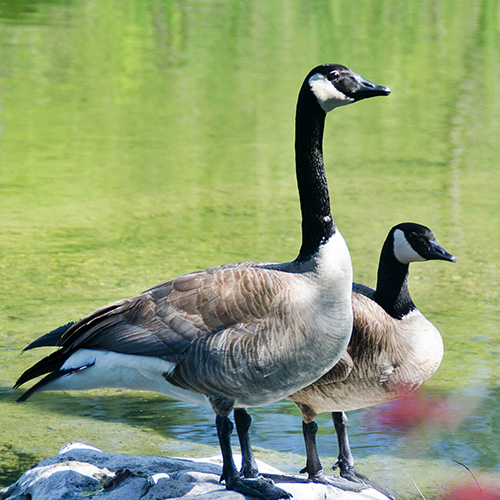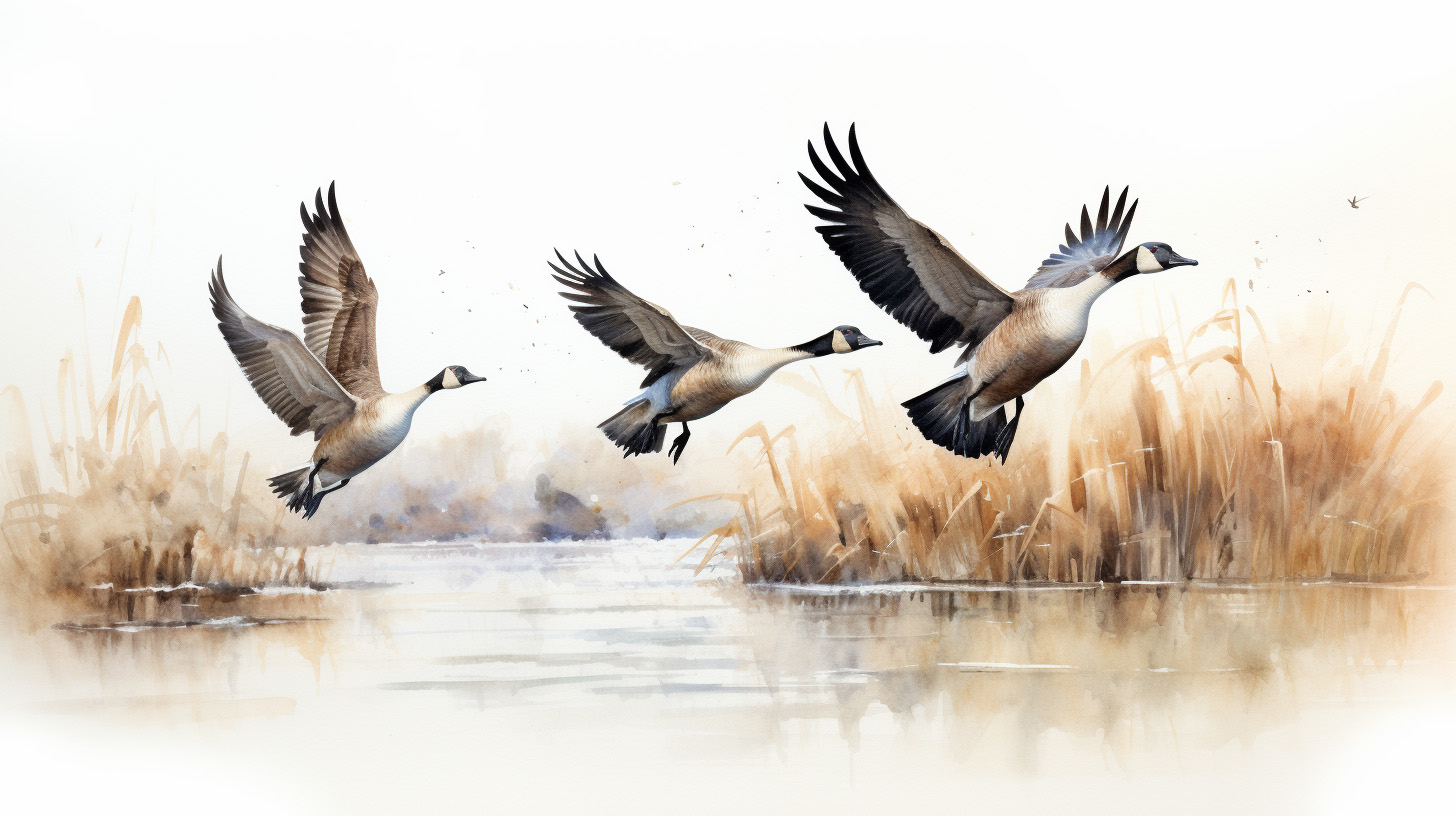This page may contain affiliate links.
Read our disclosure and privacy policy here.
Imagine a bird that’s basically the size of a medium-sized dog, complete with a “honk” that sounds like a trumpet. Meet the Canada Goose, a waterfowlWaterfowl are birds that are specially adapted to live around water, like ducks, geese, and swans. They usually have webbed feet for swimming and beaks that are good for scooping up aquatic plants and small creatures. These birds are often found in wetlands, lakes, and rivers, where they eat, breed, and sometimes even migrate. Learn More species known for its distinctive black head and neck, and white chinstrap marking. You’ve probably seen them hanging out in parks, golf courses, and bodies of water across North America. But did you know that many of these geese embark on an epic journey every year, traveling thousands of miles just to hang out in a different climate? Well, buckle up, because the Canada Goose migrationMigration is the regular movement of animals from one place to another, often to find food or better weather. It’s a seasonal trip that many animals take for survival. Learn More is a fascinating tale of instinct, survival, and a LOT of flying.
Table of Contents
A Great Journey: The Canada Goose Migration
Why Do Canada Geese Migrate?
Winter is a tough season for these geese. The water bodies they love so much start to freeze over, and food becomes scarce. In order to survive, they need to head to more temperateTemperate refers to a climate that’s not too hot and not too cold, with moderate rainfall and distinct seasons like spring, summer, fall, and winter. You’ll find temperate areas in parts of North America, Europe, and Asia. It’s the kind of climate where you can see a wide variety of plants and animals, including deciduous trees that lose their leaves in the fall. Learn More areas where food is abundant and water is liquid. This migration isn’t a casual trip; it’s an absolute necessity. They often travel during the day, but also sometimes at night to avoid predators, taking advantage of the moon and stars for navigation.
How Do Canada Geese Know When It Is Time To Migrate In The Fall?
You might wonder how Canada Geese know when it’s time to leave. Well, they have no calendars or clocks; they take cues from the environment. As the days grow shorter and the air becomes crisper, an instinct kicks in. These birds gather in flocks, often mixing with other waterfowl for the journey ahead. It’s almost like an ancient language spoken between them and the Earth, one that prompts them to get ready for the trek.

Did You Know?
Did You Know?
Download Printables
Fascinating Tidbits About Canada Geese
- The V-formation the geese fly in isn’t just for show; it actually conserves energy by reducing wind resistance.
- These birds are high-flyers, sometimes reaching altitudes of up to 9,000 feet. Imagine being that high without an airplane!
- Some geese mate for life, showcasing a level of commitment that is quite remarkable in the animal kingdom.

Where Do Canada Geese Go When They Migrate?
Their flight takes them as far south as the southern United States and even into Mexico. Interestingly, they often migrate to the same areas year after year. The consistency is striking—like a bird version of a family holiday spot. Once there, they don’t just lounge around; it’s a time for serious eating to rebuild the energy reserves they’ve burned during their long flight. It’s also a chance for younger geese to mature in an environment that’s a bit more forgiving.
How Do Canada Geese Know When Its Time To Come Back?
As winter loosens its grip and spring arrives, the geese sense the change. A combination of longer daylight hours and rising temperatures serves as their cue. But it’s not just about the weather; they also have a compelling urge to return to their breeding grounds. It’s almost as if the landscapes of their birth are calling them home to continue the cycle of life.
What Do Canada Geese Do Once They Migrate Back North?
Once they arrive back in their northern territories, it’s time for the next generation. Females typically lay between 2-9 eggs and choose nesting spots with wide, open views. For about a month, the mother incubates the eggs, while the father keeps a watchful eye for predators. When the goslings hatch, both parents are involved in their upbringing, teaching them to forage, swim, and eventually, to fly. The family unit remains tight, often sticking together for the first year of the goslings’ lives.
Do All Canada Geese Migrate?
Not all Canada Geese feel the need to migrate. In milder climates, where food is available year-round, some decide to stay put. These are called “resident geese.” They’ve adapted to local conditions and find it unnecessary to undertake the perilous journey that their migrating cousins do.
The Great Journey Of The Canada Geese
The migration of the Canada Goose is more than just a seasonal move; it’s a complex behavior ingrained in the very fabric of the bird’s life. Each year, they embark on an awe-inspiring journey, fueled by instinct, environmental cues, and a deep-rooted connection to their homeland. It’s an ongoing cycle, a continuous loop that links generations of Canada Geese in a chain of survival, instinct, and natural brilliance.

DISCUSSION
DISCUSSION
DISCUSSION
FOLLOW-UP TOPICS
Science Topics
Environmental Cues in Animal Behavior
Initiating the Discussion: Ask the kids what they think triggers the Canada Geese to know it’s time to migrate. Is it like a built-in alarm clock? Do they get a special message from nature?
Learning Opportunity: This discussion can teach kids about how animals, including humans, are influenced by environmental factors like temperature and light. They can explore how these cues can set off behaviors that have evolved over thousands of years for survival.
Family Bonds in the Animal Kingdom
Initiating the Discussion: Point out how both parents in a Canada Goose family are involved in raising their young. Ask the kids if they can think of other animals where both parents are involved in childcare.
Learning Opportunity: This topic can help kids appreciate the diversity of family structures in the animal kingdom and can lead to a broader conversation about roles and responsibilities within their own families.
Adaptations for Long-Distance Travel
Initiating the Discussion: Share that Canada Geese fly in a V-formation to save energy and can fly up to 9,000 feet high. Ask kids to brainstorm why these adaptations might be beneficial for the geese.
Learning Opportunity: This opens up a discussion on the concept of biological adaptations. Kids can learn how animals develop specific characteristics or behaviors over time to better survive in their environments.
The Non-Migrators
Initiating the Discussion: Ask the children why they think some geese don’t migrate. Is it easier or harder for them? What could be the advantages and disadvantages?
Learning Opportunity: This will teach kids about the concept of ecological niches and how animals can adapt to different environments in various ways, sometimes even leading to sub-groups within the same species that behave differently.

There’s a lot to explore right where we are, in our own neighborhoods and backyards! Join us while we get off the couch and explore the everyday wonders of nature, science, space, engineering, art, and anything else we stumble upon during on our adventures.



